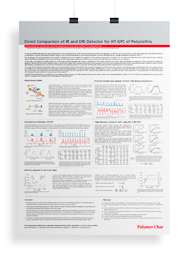The Two-Dimensional Solvent Gradient Interaction Chromatography (SGIC 2D) instrument performs an analytical fractionation of the polymer according to chemical composition by selective adsorption/desorption on an HPLC column, followed by a second separation according to molar mass on a Gel Permeation Chromatography (GPC) / Size Exclusion Chromatography (SEC).
The instrument is fully automated and the whole process is controlled by the virtual instrumentation software. Once the vials with the dry polymer samples are placed in the autosampler’s external tray, the instrument takes care of the vial-filling with solvent, dissolution with gentle shaking, optional in-line filtration, and injection into the HPLC column. Then the solvent gradient program starts, and the resulting fractions are injected towards the GPC/SEC columns.
The detection is done by a standard infrared detector at the exit of the GPC/SEC columns, which provides a linear response and outstanding stability, overcoming this way the limitations in detection found in single dimension SGIC due to the varying mobile phase composition.
At the end of the analysis, the two-dimensional distribution interrelating molar mass and chemical composition are obtained. This combined information is often required for the comprehensive characterization of complex materials. The SGIC 2D is especially suitable for the analysis of samples of low crystallinity or complex polarity distribution when the classic cross-fractionation technique based on crystallization (TREF/GPC) does not provide the desired separation.
Polymer Char’s analytical SGIC 2D instrument is a practical alternative to preparative fractionation methods, which are sometimes tedious and time-consuming. The composition molar mass interdependence is now measured in hours instead of days, with limited solvent consumption and no manual intervention, in an intrinsically safe set-up.
The SGIC 2D can also be used as a regular High-temperature GPC/SEC equipment without the need to modify anything in the hardware or additional steps by the user. The smart design and powerful control software allow the instrument to run in either SGIC 2D mode or in a regular GPC mode.
SGIC is a technique developed and patented by The Dow Chemical Company and licensed to Polymer Char.














